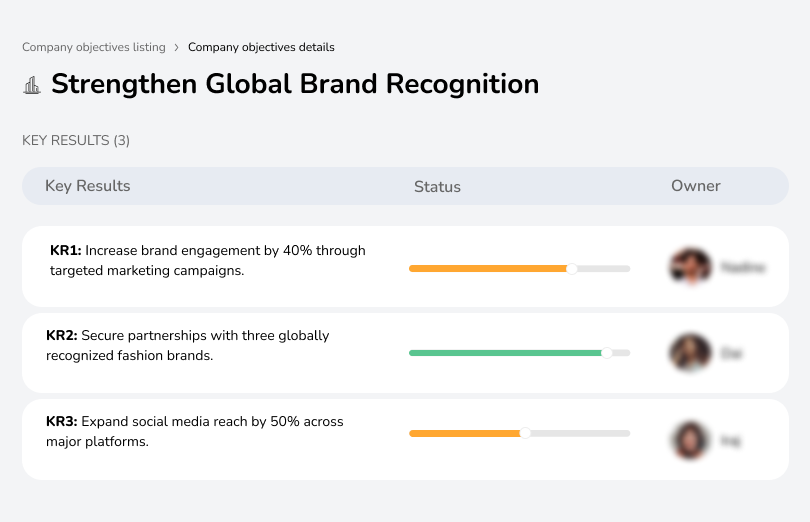Free OKR Templates
Download templatesThe CEO of a textiles manufacturer is responsible for defining the company’s strategic vision and ensuring its successful execution across all business areas. They oversee operations, drive innovation, and focus on expanding market presence while aligning with long-term organisational goals.
This role involves making critical decisions, building stakeholder relationships, and addressing industry challenges, including sustainability, ethical production, and competitive market dynamics. The CEO collaborates with the executive team to optimise operations, ensure high-quality output, and enhance customer satisfaction.
In textile manufacturing, the CEO plays a crucial role in driving business growth, championing innovation, and maintaining the company’s leadership in the industry while upholding sustainability and ethical practices as core values.
15 OKR Templates for CEO (Textiles Manufacturing)
1. Challenge: Limited market presence in emerging regions hinders growth potential
Objective: Drive Revenue Growth Through Market Expansion
Owned by: CEO
Due date: 6 months
- KR1: Increase market share by 15% in three emerging markets.
- KR2: Launch two new product lines tailored to regional demands.
- KR3: Achieve a 10% revenue growth quarter-over-quarter.
2. Challenge: Increasing pressure to meet sustainability benchmarks
Objective: Enhance Sustainability Practices Across Operations
Owned by: CEO
Due date: 5 months
- KR1: Reduce carbon emissions by 20% through energy-efficient processes.
- KR2: Source 50% of raw materials from sustainable suppliers.
- KR3: Obtain two sustainability certifications for key facilities.
3. Challenge: High production costs reduce competitiveness
Objective: Optimize Production Efficiency
Owned by: CEO
Due date: 5 months
- KR1: Increase production output by 25% without increasing costs.
- KR2: Decrease production downtime by 30% through predictive maintenance.
- KR3: Implement lean manufacturing practices in 100% of facilities.
4. Challenge: Rising operational costs impact profitability
Objective: Strengthen Financial Health
Owned by: CEO
Due date: 6 months
- KR1: Reduce operational expenses by 15% through cost optimization initiatives.
- KR2: Increase profit margins by 10% within the next two quarters.
- KR3: Secure $5 million in funding for business expansion and R&D.

5. Challenge: Stagnant product designs impact market competitiveness
Objective: Foster Innovation in Product Development
Owned by: CEO
Due date: 6 months
- KR1: Launch three innovative textile products catering to premium markets.
- KR2: Increase R&D budget allocation by 20%.
- KR3: File five new patents for innovative textile technology.

6. Challenge: Employee engagement and retention need improvement
Objective: Build a High-Performance Organizational Culture
Owned by: CEO
Due date: 5 months
- KR1: Conduct leadership training programs for 100% of managers.
- KR2: Increase employee satisfaction scores by 15%.
- KR3: Reduce employee turnover rate by 10%.

VP of Engineering (Automotive Manufacturing) Templates: Click here
7. Challenge: Limited digital adoption slows decision-making and efficiency
Objective: Expand Digital Transformation Initiatives
Owned by: CEO
Due date: 6 months
- KR1: Digitize 70% of operational workflows.
- KR2: Implement advanced analytics for real-time performance monitoring.
- KR3: Improve supply chain transparency by integrating digital tracking systems.
8. Challenge: Customer retention is low due to inconsistent service quality
Objective: Enhance Customer Experience and Satisfaction
Owned by: CEO
Due date: 5 months
- KR1: Achieve a 20% increase in repeat customer rate.
- KR2: Reduce customer complaints by 30%.
- KR3: Launch a loyalty program to reward high-value customers.
9. Challenge: Low brand visibility impacts global sales
Objective: Strengthen Global Brand Recognition
Owned by: CEO
Due date: 6 months
- KR1: Increase brand engagement by 40% through targeted marketing campaigns.
- KR2: Secure partnerships with three globally recognized fashion brands.
- KR3: Expand social media reach by 50% across major platforms.
10. Challenge: Supply disruptions affect timely production and delivery
Objective: Improve Supply Chain Resilience
Owned by: CEO
Due date: 6 months
- KR1: Identify and onboard 10 new reliable suppliers.
- KR2: Reduce lead time by 25% through supply chain optimization.
- KR3: Establish a risk mitigation plan covering 100% of critical supply chain points.

11. Challenge: Competitors are adopting advanced technologies faster
Objective: Drive Industry Leadership in Technology Adoption
Owned by: CEO
Due date: 6 months
- KR1: Implement AI-driven quality control systems in all plants.
- KR2: Increase production automation by 30%.
- KR3: Integrate IoT-enabled devices for real-time monitoring of operations.

12. Challenge: Lack of collaboration limits growth opportunities
Objective: Establish Strategic Partnerships
Owned by: CEO
Due date: 5 months
- KR1: Secure partnerships with five global retailers.
- KR2: Develop two co-branded products with key industry players.
- KR3: Increase revenue from partnerships by 15%.








